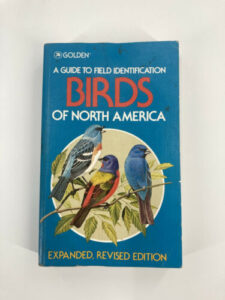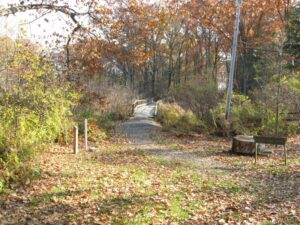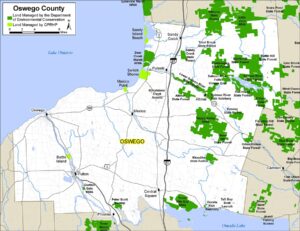This post kicks off the start of my new blog, tentatively called In Sympathy with Nature. As a self-described nature nerd, my plan is to use it as a platform for sharing various field and travel experiences with a focus around my interests in birding and native plant gardening.
Lately, I have been thinking about when did my avian journey truly began? what helped stoke the interest? and when did the roots fully take form? I’ve increasingly come to the conclusion that my mother’s low-key yet sustained interest in birds was a key factor.
During my growing up years, I vividly recall her love for all things related to the spring, that special season of rebirth that occurs each March, April and May. While she would never have called herself a “birder,” per se, as a teenager I remember she had couple of palm-sized copies of the Golden Field Guides: Birds of North America at strategic picture windows throughout our house – ready for a quick scan for a bird she wasn’t quite sure of.
related to the spring, that special season of rebirth that occurs each March, April and May. While she would never have called herself a “birder,” per se, as a teenager I remember she had couple of palm-sized copies of the Golden Field Guides: Birds of North America at strategic picture windows throughout our house – ready for a quick scan for a bird she wasn’t quite sure of.
Mom grew up on a family farm in upstate New York, in a small town called Mexico – just east of Oswego, and literally only a couple miles from the southeast corner of Lake Ontario. I’ve come to realize that Oswego County is a unique place across the seasons, driven in large part by the fact that it is located where the lake abruptly turns north toward Canada, and connects to the mouth of the St. Lawrence River (that flows east into the Thousand Islands). In winter, all along the coast (and up to 30-40 miles inland), towns like Mexico are governed by unfathomable lake-effect snowfalls, with annual accumulations regularly above 300″ per year (among the highest in the US). Growing up, my family would often receive letters from our Aunt Dorothea (who lived in Oswego until the ripe old age of 93), that would document and monitor in great detail how many inches of snow the area had received so far that year. You had to be a hearty sole to live there.
The Birds
But I’ve also recently learned that the region is also a haven for birds, and bird migration, especially in the spring – as the southeastern shore of Lake Ontario lies in the middle of one of the four main paths of the Atlantic Flyway!
Little did mom know it at the time, but years later Onondaga Audubon established the Derby Hill Bird Observatory not more than five miles from the town of Mexico. It is “one of the premier hawk watches in the Northeastern United States.” Since 1979, they have been conducting Hawk counts every year in a very standardized way. Set high on a bluff overlooking the lake are two watch towers, and “on average 40,000 raptors are counted each spring as they migrate northwards.” Apparently, in mid-April, it is not unusual to see as many as 2,000 raptors a day, including Bald and Golden Eagles, Red-tailed, Broadwinged and Swainson’s Hawks, Merlins and Peregrine Falcons, among others. The thermals must be amazing on the bluffs.
But spring migration doesn’t stop with the raptors. Almost 300 bird species have been sighted at Derby Hill over the years on eBird. March brings the icterids (e.g., Red-winged Blackbirds, Grackles, Cowbirds), while a broad mix of passerines begin to be seen in April (e.g., thrushes, tanagers, sparrows, thrashes, finches, jays, nuthatches, chickadees). At the edge of the lake, it is apparently easy to spot ducks migrating, along with many species of terns, gulls, herons and egrets. Most of the warblers arrive in May, along with vireos, flycatchers and other smaller songbirds / passerines.

When my family would have the occasional visit north, on warmer days I remember Mom taking us to Mexico Point State Park (SP), and occasionally to Selkirk Shores SP. My older brother Doug, who grew up in Mexico from 1943 into the early 1950, remembers Mexico Point as being one of her favorite places. I’ve learned that there are several scenic trails within the 120 acre park, including a 1/4 mile trail to historic Spy Island and Roop’s Loop, and the 3/4 mile self-interpretive nature trail.
Mexico Point Park lies just a 1/2 mile west of Derby Hill along Lake Ontario, while Selkirk Shores lies just 1 1/2 miles to the east. More than 180 bird species have been reported in eBird at Mexico Point SP over the years, whereas over 200  bird species have been reported at Selkirk Shores SP (on fewer than 300 completed checklists no less). Just a bit further up the road lies Sandy Island SP along the eastern shore of the lake. Selkirk Shores and Sandy Island are designated important Bird Conservation Areas by New York State given their important marshy landscape, as is Deer Creek Marsh WMA which lies between Selkirk Shores SP and Sandy Island SP (with an eBird count of 199).
bird species have been reported at Selkirk Shores SP (on fewer than 300 completed checklists no less). Just a bit further up the road lies Sandy Island SP along the eastern shore of the lake. Selkirk Shores and Sandy Island are designated important Bird Conservation Areas by New York State given their important marshy landscape, as is Deer Creek Marsh WMA which lies between Selkirk Shores SP and Sandy Island SP (with an eBird count of 199).
In researching the area, I was happy to read that the endangered Piping Plover is making a comeback along the shores of the eastern Great Lakes, with 4 chicks hatched this year at Sandy Island SP. Only 40 years ago they were almost extinct from the Great Lakes region. This is a great success story of collaboration and team learning, with scientists from ECF SUNY College of Environmental Science and Forestry (ESF) taking the lead in restoring habitat that encourages the Piping Plover to return, after similar success by other environmentalists in Michigan.
Given this backdrop, it isn’t surprising that Mom gained a special appreciation for the birds and the amazing migration spectacle that occurs each and every spring. While she wasn’t super vocal about the birds, she maintained an interest well into her 90s, as she just loved it when I would visit and fill up the bird feeder outside her bedroom window. I’d like to think that the seeds of my interest in ornithology came from her, who certainly learned from it from her mother Mae. Not only did grandma Mae maintain a very large Purple Martin house on the farm, but Doug recalled that “she always had a canary in a cage [in the house] that she would be cooing to.” She must have loved it when the birds would return to her each spring.
